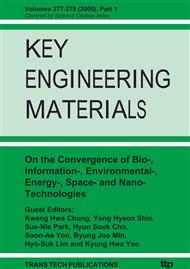p.809
p.816
p.824
p.831
p.838
p.845
p.851
p.857
p.865
Integration of Landsat ETM+ and Radarsat SAR Data for Land Cover Classification
Abstract:
This study aims to analyze the synergic effect of integrating two distinctive satellite remote sensor data (optical and microwave imagery) for land cover classification. The study area covers diverse land cover types in the Western coastal region of the Korean peninsula. Eleven land cover types were classified using several datasets of combined Landsat ETM+ and Radarsat synthetic aperture radar (SAR) data as well as only a single dataset of either ETM+ or SAR data alone. Furthermore, we introduced a texture image that was derived from the SAR data. The synergic effect of these combined datasets was evident by both image interpretation and computerassisted classification. The overall classification accuracy of the combined datasets was improved to 74.60% as compared to the 69.35% accuracy of using ETM+ data alone.
Info:
Periodical:
Pages:
838-844
Citation:
Online since:
January 2005
Authors:
Price:
Сopyright:
© 2005 Trans Tech Publications Ltd. All Rights Reserved
Share:
Citation:


